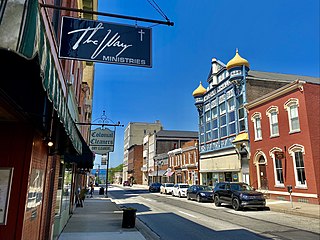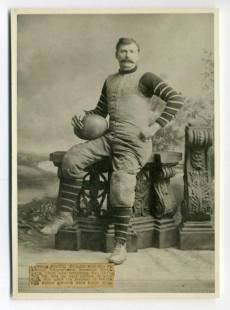Related Research Articles

Latrobe is a city in Westmoreland County, Pennsylvania, in the United States and part of the Pittsburgh metropolitan area.
George Oliver Barclay was an American football and baseball player. He played Major League Baseball for the St. Louis Cardinals and later the Boston Beaneaters. He was also an early professional football player-coach for the Greensburg Athletic Association. He was nicknamed "The Rose" for his concern with his looks and "Deerfoot" because of his speed. Barclay also invented the first football helmet.
The Allegheny Athletic Association was an athletic club that fielded the first ever professional American football player and later the first fully professional football team. The organization was founded in 1890 as a regional athletic club in Allegheny, Pennsylvania, which is today the North Shore of Pittsburgh.
The Latrobe Athletic Association was a professional football team located in Latrobe, Pennsylvania, from 1895 until 1909. A member of the unofficial Western Pennsylvania Professional Football Circuit, the team is best known for being the first football club to play a full season while composed entirely of professional players. In 1895, team's quarterback, John Brallier, also became the first football player to openly turn professional, by accepting $10 and expenses to play for Latrobe against the Jeannette Athletic Club.

John Kinport "Sal" Brallier was one of the first professional American football players. He was nationally acknowledged as the first openly paid professional football player when he was given $10 to play for the Latrobe Athletic Association for a game against the Jeanette Athletic Association in 1895.
The Greensburg Athletic Association was an early organized football team, based in Greensburg, Pennsylvania, that played in the unofficial Western Pennsylvania Professional Football Circuit from 1890 until 1900. At times referred to as the Greensburg Athletic Club, the team began as an amateur football club in 1890 and was composed primarily of locals before several professional players were added for the 1895 season. In 1894 it was discovered that the team had secretly paid formerly Indiana Normal player, Lawson Fiscus, to play football and retained his services on salary. The team was the chief rival of another early professional football team, the Latrobe Athletic Association.
The Duquesne Country and Athletic Club was a professional football team based in Pittsburgh, Pennsylvania from 1895 until 1900. The team was considered one of the best, if not the best, professional football teams in the country from 1898 until 1900. However, the team is most famous for being the first football franchise to be owned by an individual, William Chase Temple.

Ira Lawson Fiscus (1866-1949) was one of the first professional football players. He attended Princeton University, where his outstanding play at offensive guard earned him the title Samson of Princeton, before going on to play professionally with the Allegheny Athletic Association in 1891 and the Greensburg Athletic Association in 1893. His brothers Ross and Newell also played for Pittsburgh-area athletic clubs and were highly regarded as players.

Charles Edgar "Blondy" Wallace was an early professional football player and later convicted criminal during the Prohibition Era. He was a 240-pound, former Walter Camp second-team All-American tackle from the University of Pennsylvania. He also played two years at Peddie Institute, in New Jersey, winning state championships in 1896 and 1897. During his professional playing career he was involved in almost every major event in professional football between 1902 and 1907. Over that timespan he played for the independent Philadelphia Athletic Club, the Philadelphia Athletics of the first National Football League, the "New York" team and the Syracuse Athletic Club in the 1902 World Series of Football, the Franklin Athletic Club and the Canton Bulldogs of the Ohio League.

David J. Berry was an American football manager during the late 19th and early 20th centuries. He was the top promoter for the sport during that time period. He is credited with inventing the "all-star game concept" in 1898, and also helped to form one of the first organized football leagues in 1902.
James Edward Blair was an American football player and coach and physician. He was early professional football player with the Latrobe Athletic Association. He later relocated to Burlington, New Jersey where he took a prominent part in the city council for a time and was a surgeon for the Third Battalion of the New Jersey National Guard. He was a charter member of the Burlington Elks Lodge and was a thirty-second degree Mason. He also was affiliated with the Sons of Veterans.
Albert Russell Aukerman was an early professional football player-coach for the Latrobe Athletic Association. Prior to that, he was a halfback at Gettysburg College. He entered the College in 1893 at the age of 20. Because of his maturity, he was elected captain of the football team. He emerged as one of the premier rushers of his day. Over a three-year period, he produced the winning points in wins over Dickinson, Washington & Jefferson, Franklin College and Marshall University. He was also an accomplished track athlete for Gettysburg, running the 100 and 200 meter relays and also the long jump. He left school to become a physical instructor at the Latrobe A. A. He was then picked to be the team's first head coach in 1895. He formed what became one of the first professional football teams and is credited with scoring the first professional touchdown, with John Brallier in a game against the Jeannette Athletic Club. Aukerman also played pro football for the Duquesne Country and Athletic Club for two games in 1895 at Exposition Park
Pro Football: Its Ups and Downs, published in 1934, is a novel by Dr. Harry March that was the first ever attempt to write a history of professional American football. March had served in several executive offices with the New York Giants of the National Football League in the late 1920s and was a founder of the second American Football League. The book, while popular and entertaining with some important information and interesting anecdotes, is often viewed as inaccurate by modern sports historians. Jack Cusack, manager of the Canton Bulldogs from 1912 to 1917, summed up the book's flaws by stating; "In my library is a book... entitled Pro Football: Its "Ups and Downs" and in my opinion it is something of a historical novel."
John "Jack" Gass was an early professional football player. He played mostly with the Latrobe Athletic Association from 1895 until 1899. In 1898 he was a member of the Western Pennsylvania All-Stars, which was a team put together by Latrobe manager Dave Berry for the purpose of challenging the star-filled Duquesne Country and Athletic Club to the first pro football all-star game held at Exposition Park in Pittsburgh. The All-Stars lost to Duquesne, 16-0. In 1897, Gass was a member of the very first all-professional football team, in Latrobe, to play a complete season together. In 1900, he played for Latrobe's rival, the Greensburg Athletic Association.
A. S. Valentine was an early professional football player for the Allegheny Athletic Association. He served as the team's quarterback in 1890 and 1891. However, he jumped to the rival Pittsburgh Athletic Club in 1892. Valentine played for Pittsburgh in their first two games. Then, without warning, he suddenly jumped back to the Allegheny team. Some Pittsburgh A.C. members accused Allegheny of enticing him back, while others charged he had all along been a spy for them. During Allegheny's two games against the Pittsburgh A.C. that year, Valentine played as a left halfback.
The 1894 Greensburg Athletic Association season was their fifth season in existence. The team finished 6–1–1.
Arthur Lamont "Tiger" McFarland was an early professional American football player who played with the Greensburg Athletic Association as well as the Latrobe Athletic Association. He later played for the Philadelphia Athletics in the 1902 version of the National Football League and for the 1903 US Football Champions, the Franklin Athletic Club. Sweet also won, with Franklin, the 1903 World Series of Football, held that December at Madison Square Garden.
American football in Western Pennsylvania, featuring the city of Pittsburgh and surrounding areas, has had a long and storied history, dating back to the early days of the sport. All levels of football, including high school football and college football, are followed passionately, and the area's National Football League (NFL) team, the Pittsburgh Steelers, is consistently one of the sport's most popular teams. Many of the NFL's top stars have come from the region as well, especially those that play quarterback, earning Western Pennsylvania the nickname "Cradle of Quarterbacks".

Offutt Field is a multi-purpose athletic field, located in Greensburg, Pennsylvania. It is currently used by the Greensburg-Salem School District and Seton Hill University, primarily as a football field. The stadium was called Athletic Park, until 1928 when Greensburg-Salem renamed the field after James H. Offutt, a community leader and school director. The school district had previously purchased the land in December, 1916. Purchase price for the 4.4-acre site was $17,166.66. The Greensburg Athletic Association, an early organized football team based in Greensburg, played their home games at the stadium from 1890–1900. The stadium has also hosted minor league baseball, Little League baseball and track and field.
The Western Pennsylvania Professional Football Circuit was a loose association of American football clubs that operated from 1890 to approximately 1940. Originally amateur, professionalism was introduced to the circuit in 1892; cost pressures pushed the circuit to semi-professional status from about 1920 through the rest of its existence. Existing in some form for 48 years, it was one of the longest-lived paying football loops to operate outside the auspices of the National Football League.
References
- ↑ Johnson, Pearce (1987). "When Did They Start?" (PDF). Coffin Corner. Professional Football Researchers Association. 9 (6): 1–5. Archived from the original (PDF) on 2010-11-27.
- ↑ Riffenburgh, Beau & Bob Carroll (1989). "The Birth of Pro Football" (PDF). Coffin Corner. Professional Football Researchers Association. 11 (Annual): 1–30. Archived from the original (PDF) on 2010-11-27.
- ↑ PFRA Research. "Five Hundred Reasons" (PDF). Coffin Corner. Professional Football Researchers Association: 1–6. Archived from the original (PDF) on 2010-09-29.
- ↑ PFRA Research. "The A's Have It" (PDF). Coffin Corner. Professional Football Researchers Association: 1–4. Archived from the original (PDF) on 2010-11-26.
- ↑ Van Atta, Robert (1981). "The Early Years of Pro Football in Southwestern Pennsylvania" (PDF). Coffin Corner. Professional Football Researchers Association. 3 (Annual): 1–21. Archived from the original (PDF) on 2009-03-26.